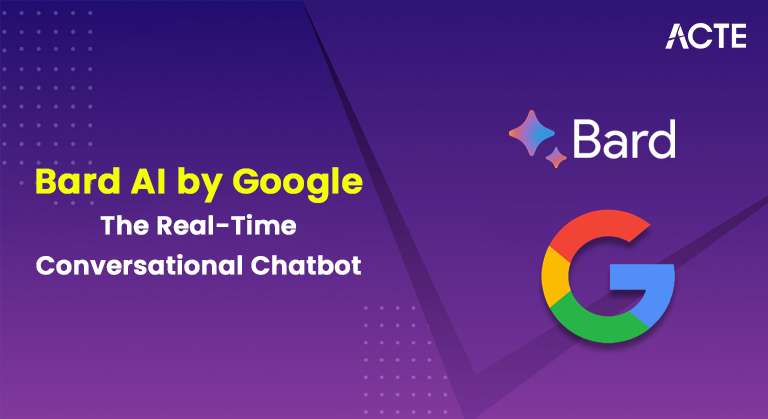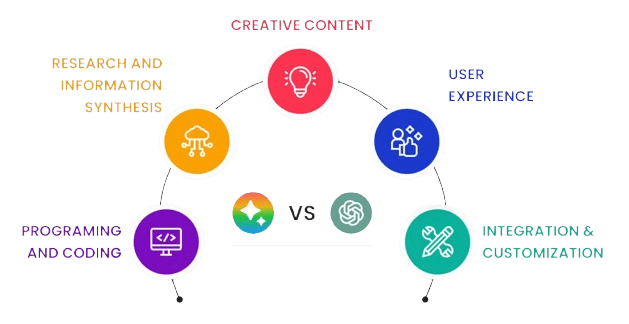
- Introduction to Bard AI
- How Bard AI Works
- Google’s AI Chatbot vs ChatGPT
- Key Features of Bard AI
- Applications of Bard AI
- Limitations of Bard AI
- How Bard AI Processes Information
- Comparison with Other AI Chatbots
- Security and Ethical Concerns of Bard AI
- Conclusion
Introduction to Bard AI
Bard AI is an advanced AI chatbot developed by Google that was built to generate human-like responses to queries. It leverages cutting-edge natural language processing (NLP) techniques and machine learning models to understand and produce real-time, coherent, contextually appropriate responses. Bard AI is designed to compete with other leading chatbots in the market, such as OpenAI’s ChatGPT, by offering users an intuitive and highly interactive experience. Bard is a product of Google’s vast experience in search engines, data processing, and AI technologies, positioning it as a strong player in the AI-driven conversational tools sector.
Eager to Acquire Your Data Science Certification? View The Data Science Course Offered By ACTE Right Now!
How Bard AI Works
Bard AI is powered by Google’s LaMDA (Language Model for Dialogue Applications) technology, a deep learning-based model specifically designed to handle natural conversations. LaMDA’s primary function is to generate human-like dialogue responses, enabling Bard to hold conversations ranging from casual chit-chat to more specialized information queries. Bard’s architecture is based on neural networks that are on vast amounts of text data from diverse sources. The AI uses these datasets to recognize patterns in language, understand context, and produce accurate, relevant responses. In addition to LaMDA, Bard leverages other technologies developed by Google, such as Google’s search engine capabilities and Data Science Training, which provide real-time, relevant information to the AI.
Key components of Bard AI include:
- NLP Engine: For understanding the nuances of human language, such as syntax, semantics, and context.
- Contextual Understanding: Bard can remember the context of the conversation, allowing for more fluid, dynamic, and relevant responses.
- Real-Time Information: Bard can pull data from the web to provide up-to-date and accurate answers to user queries.
Google’s AI Chatbot vs ChatGPT
When comparing Bard AI to ChatGPT, it’s essential to understand the differences in their design, training, and capabilities:
| Aspect | Bard AI | ChatGPT |
|---|---|---|
| Underlying Model | Uses Google’s LaMDA, fine-tuned for conversational dialogue with focus on engaging discussions. | Built on OpenAI’s GPT architecture, trained to generate human-like text across various topics |
| Knowledge Base | Pulls real-time data from the web via Google Search, ensuring constantly updated information. | Fixed knowledge base from training data (e.g., GPT-4 up to 2021); does not access live web data. |
| Purpose and Use | Designed specifically for conversation and real-time information retrieval. | General-purpose AI with wide-ranging applications like writing, coding, summarizing, and research. |
| Accuracy & Relevance | Integration with Google Search provides accurate, timely, and dynamic responses. | Impressive language capabilities but may not be up-to-date with real-world events due to lack of live data. |

Key Features of Bard AI
- Real-Time Web Access: Bard can access real-time data from the internet, providing answers that reflect the latest information.
- Advanced Conversational Abilities: Bard is designed to excel in maintaining fluid, contextually aware conversations over more extended dialogues.
- Natural Language Understanding: Thanks to AWS Lambda, Bard can understand and respond to conversational nuances, including sarcasm, idiomatic expressions, and tone.
- Integration with Google’s Ecosystem: Bard benefits from integration with Google Search, Google Maps, and other Google services, enabling it to provide highly relevant, contextual, and localized answers.
- Multilingual Capabilities: Bard can engage in multiple languages, making it accessible to a broader audience globally.
- Accessibility on Multiple Platforms: Bard is available on numerous web and mobile platforms to ensure easy access across various devices.
- Dependence on Data Quality: Like all AI models, Bard’s responses are only as good as the data it is trained on. Poor-quality or biased data can lead to inaccurate or inappropriate responses.
- Contextual Understanding: While Bard understands context well, it is still a machine and can sometimes misinterpret complex or ambiguous conversations.
- Limited Emotional Intelligence: While Bard can simulate empathy and emotional understanding, it lacks the accurate emotional intelligence of a human and can sometimes appear robotic in emotional conversations.
- Reliability: As Bard relies on real-time information from the web, there’s always a risk of incorrect or misleading data influencing its responses.
- Security and Privacy: Concerns around data privacy may arise when Bard accesses information from various web sources or users’ past interactions.
- Bard AI: Uses LaMDA and integrates Google’s powerful search engine.
- ChatGPT : Uses GPT-based models from OpenAI and is trained on vast text datasets without real-time web access.
- Other Chatbots: Many other AI chatbots use a mix of NLP and rule-based systems, making them less dynamic and conversational than Bard or ChatGPT.
- Bard AI: Real-time information from the web ensures answers are up-to-date.
- ChatGPT : Limited to knowledge until its last update and lacks real-time data.
- Other Chatbots: Many rely on static datasets, so their accuracy deteriorates over time.
- Bard AI: Best suited for dynamic conversations, real-time information retrieval, and conversational AI tasks.
- ChatGPT : Best for generating coherent text, writing, and creative tasks.
- Other Chatbots: Often focused on specific domains or tasks, such as customer service or FAQs.
- Improved Contextual Understanding: Future versions may exhibit even more advanced contextual understanding, allowing for deeper and more nuanced conversations.
- Better Integration with Google Ecosystem: Bard could integrate more deeply with Google services to offer enhanced productivity tools, data handling, and assistance.
- Enhanced Personalization: By analyzing past interactions, Bard could become more personalized in its responses, understanding user preferences better over time.
- Multimodal Abilities: Future versions can handle not just text but also images, audio, and video, expanding the range of tasks Bard can assist with.
Ready to Earn Your Data Science Certificate? View The Data Science Course Offered By ACTE Right Now!
Limitations of Bard AI
Interested in Pursuing Data Science Master’s Program? Enroll For Data Science Master Course Today!
How Bard AI Processes Information
Bard AI processes information similarly to other large-scale AI language models but places a stronger emphasis on conversational depth. The process begins with input reception, where Bard receives text-based queries or prompts from the user. It then moves into understanding and contextualization, leveraging LaMDA’s advanced natural language capabilities to interpret the user’s intent, including the context of previous messages in the conversation. For factual or knowledge-based queries, Bard utilizes its real-time web access to retrieve the most relevant and up-to-date information. Once the data is gathered, Bard uses Data Science techniques to generate a response that is contextually appropriate and coherent, leveraging its understanding of syntax, meaning, and tone. Finally, the response is delivered to the user in a natural, conversational format.

Comparison with Other AI Chatbots
Technology:
Accuracy and Updates:
Use Cases:
Security and Ethical Concerns of Bard AI
As with any AI-powered tool, Bard AI brings with it several security and ethical concerns that must be carefully considered. One of the primary issues is data privacy, as Google’s access to user data raises questions about how much personal information is collected, stored, and potentially used during interactions with Bard. Users may be unaware of the extent of data tracking, which could lead to privacy violations if not transparently managed. Another concern is bias and discrimination; like other AI models, Bard is trained on large datasets that may contain inherent societal biases. As a result, it may unintentionally generate responses that are unfair, stereotypical, or discriminatory. Additionally, because Bard retrieves information in real-time from the web, there is a risk of spreading misinformation, especially if it pulls content from unreliable or inaccurate sources, which can be particularly problematic in fields like Data science Training where accuracy is crucial. Without proper filtering and monitoring, such misinformation could be passed along to users as credible facts. Lastly, there are broader concerns around autonomy and control, particularly regarding how AI systems like Bard might influence decision-making. If not carefully designed and governed, Bard’s responses could unintentionally manipulate users’ opinions or reinforce certain viewpoints, raising ethical questions about AI’s role in shaping human behavior and discourse.
Preparing for a Data Science Job Interview? Check Out Our Blog on Data Science Interview Questions & Answer
Future Enhancements in Bard AI
Conclusion
Bard AI represents a significant step forward in the evolution of conversational artificial intelligence. Developed by Google and powered by the advanced LaMDA model, Bard offers dynamic, real-time responses by leveraging Google’s unparalleled search capabilities. Its strengths lie in its ability to understand complex language nuances, maintain contextual awareness, and provide up-to-date information, setting it apart from other AI chatbots like ChatGPT. Despite its impressive capabilities, Bard is not without limitations. It still faces challenges related to bias, data reliability, and user privacy. However, with continuous development, integration into the Google ecosystem, future enhancements such as improved personalization and multimodal input, and applications in Data Science Training, Bard is poised to become a cornerstone of AI-powered communication. Overall, Bard AI not only showcases the current potential of AI-driven dialogue systems but also paves the way for future innovations in human-computer interaction, transforming how we access and interact with information in our daily lives.


